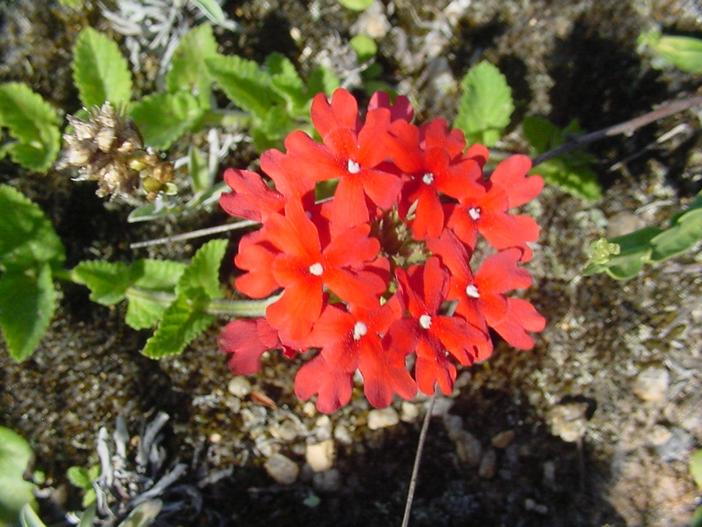Peruvian Mock Vervain
(Glandularia peruviana)
Peruvian Mock Vervain (Glandularia peruviana)
/
/

Marcia Stefani
CC BY 2.0
Image By:
Marcia Stefani
Recorded By:
Copyright:
CC BY 2.0
Copyright Notice:
Photo by: Marcia Stefani | License Type: CC BY 2.0 | License URL: https://creativecommons.org/licenses/by/2.0/ | Uploader: Marcia Stefani | Publisher: Flickr




























Estimated Native Range
Summary
Glandularia peruviana, commonly known as Peruvian mock vervain, is a perennial herb native to open woodlands and grasslands in Bolivia, southern Brazil, northern Argentina, Paraguay, and Uruguay. It typically grows to a height of 0.5-1 feet and a width of 1-2 feet. This plant is characterized by its sprawling habit and small, rounded clusters of pink and red flowers that bloom in the spring and are moderately showy. The foliage is finely textured, adding to its delicate appearance.
Peruvian mock vervain is valued for its long flowering season and its ability to attract butterflies and other pollinators. It is often used in borders, rock gardens, and as ground cover due to its low-growing nature and spreading habit. It thrives in full sun and requires medium amounts of water, making it relatively drought-tolerant once established. It prefers well-drained soils and can tolerate a range of soil types, from sandy to loamy. The cultivar ’Balendpibi’ (trade name Endurascape Pink Bicolor) is notable for its bicolored flowers and has received the Royal Horticultural Society’s Award of Garden Merit. While generally low-maintenance, Glandularia peruviana can be susceptible to powdery mildew and should be monitored for this disease. It is also important to avoid overwatering to prevent root rot.CC BY-SA 4.0
Peruvian mock vervain is valued for its long flowering season and its ability to attract butterflies and other pollinators. It is often used in borders, rock gardens, and as ground cover due to its low-growing nature and spreading habit. It thrives in full sun and requires medium amounts of water, making it relatively drought-tolerant once established. It prefers well-drained soils and can tolerate a range of soil types, from sandy to loamy. The cultivar ’Balendpibi’ (trade name Endurascape Pink Bicolor) is notable for its bicolored flowers and has received the Royal Horticultural Society’s Award of Garden Merit. While generally low-maintenance, Glandularia peruviana can be susceptible to powdery mildew and should be monitored for this disease. It is also important to avoid overwatering to prevent root rot.CC BY-SA 4.0
Plant Description
- Plant Type: Herb
- Height: 0.5-1 feet
- Width: 1-2 feet
- Growth Rate: Moderate
- Flower Color: Pink, Red, Purple, White
- Flowering Season: Spring, Summer
- Leaf Retention: Semi-Deciduous
Growth Requirements
- Sun: Full Sun
- Water: Medium
- Drainage: Medium
Common Uses
Bee Garden, Bird Garden, Border Plant, Butterfly Garden, Deer Resistant, Groundcover, Hummingbird Garden, Low Maintenance, Rock Garden
Natural Habitat
Open woodlands and grasslands
Other Names
Common Names:
Scientific Names: , Verbena melindres, Glandularia peruviana, Verbena chamaedryfolia, Verbena melindroides, Verbena platensis var. latiuscula, Verbena chamaedryfolia var. melindroides, Verbena peruviana f. rosea, Verbena coccinea, Verbena platensis var. stenodes
GBIF Accepted Name: Glandularia peruviana (L.) Small